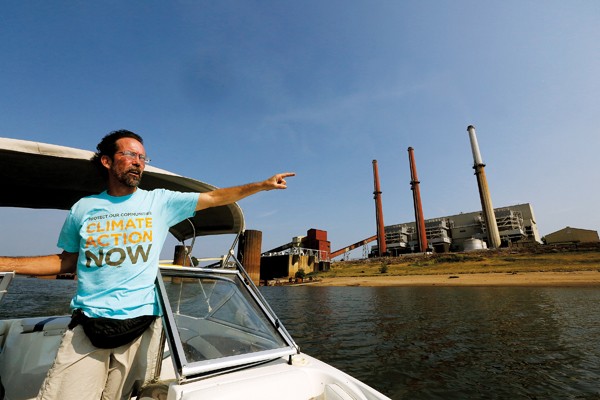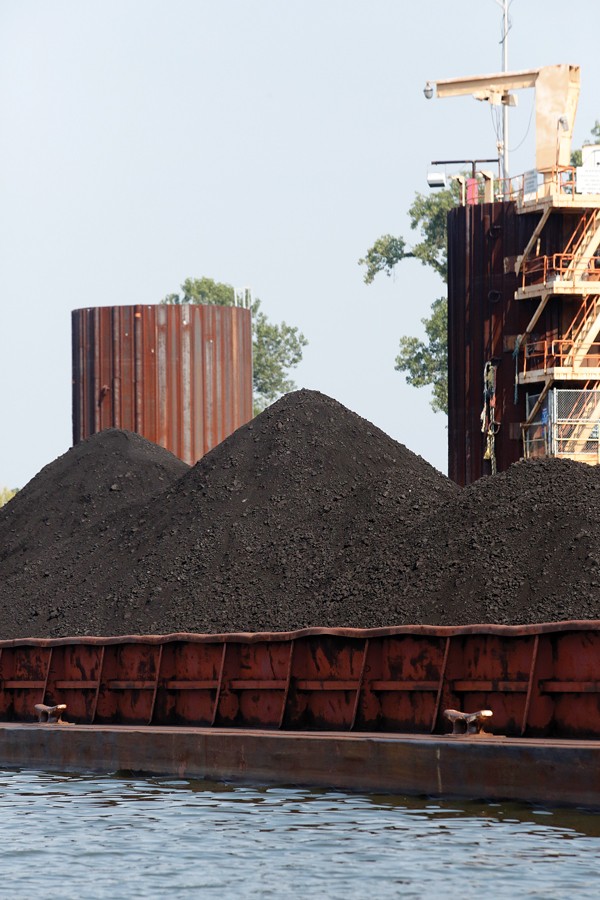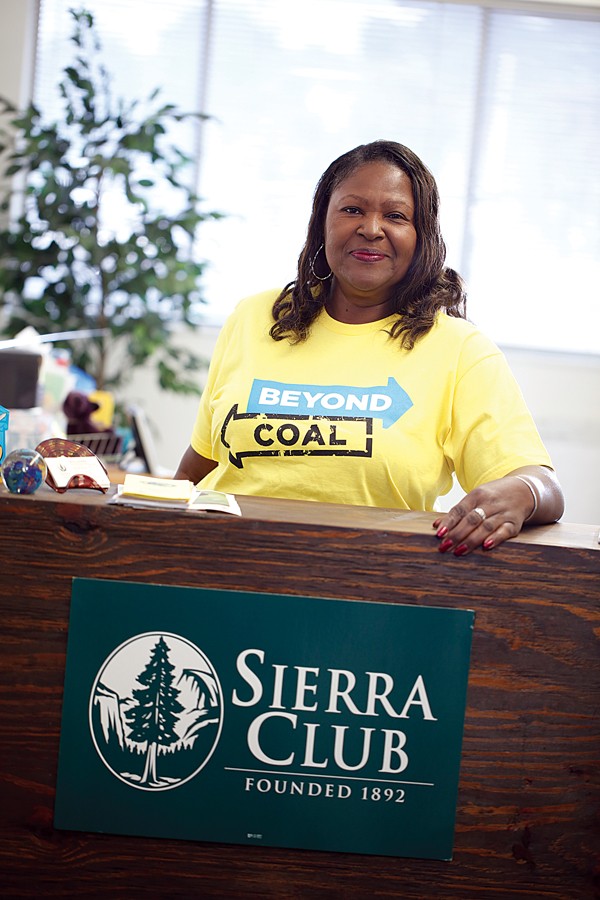The ads have been appearing in newspapers across Tennessee. They feature the three-pronged blades of a white wind turbine against a blue sky and fluffy clouds juxtaposed with a sinister-looking black-and-white photo of a rusty coal smokestack with the words “Let’s Turn, Not Burn.”
The Sierra Club has been running the ads to urge Tennesseans to contact the Tennessee Valley Authority (TVA) about its board’s upcoming vote to replace Memphis’ 60-plus-year-old coal-powered Allen Fossil Plant with a natural gas plant.
Environmentalists from the Sierra Club and the Southern Alliance for Clean Energy (SACE) say a mix of renewable energy from wind and solar power with a smaller gas plant is the way to go.
But the TVA’s Environmental Assessment, a 150-plus-page report studying multiple options for retiring the aging coal plant in Frank C. Pidgeon Industrial Park, points to building a new natural gas plant near the coal plant site with an output ranging from 600 to 1,400 megawatts of electricity. The current net capacity of the Allen plant is 750 megawatts.
Another option given consideration would be to continue running the Allen coal plant but only after installing scrubbers designed to control sulfur dioxide emissions and other contaminants.
Either way, TVA has to do something. It’s under an agreement with the Environmental Protection Agency (EPA) and several environmental groups, including the Sierra Club, to reduce emissions at its coal-fired plants by December 2018. The TVA board will vote on how to meet that agreement on August 21st at its monthly meeting in Knoxville.
Coal Vs. Natural Gas
Just two miles away from T.O. Fuller State Park in South Memphis, which was the first state park open to African Americans, are the three coal-fired units at the Allen Fossil Plant. On a clear day, one can see steam emitting from the long, cylindrical towers.
For years, TVA’s Allen plant has topped the Sierra Club’s “Terrible Ten” list of the worst industrial polluters in Shelby County, due to its emissions of carbon dioxide, sulfur dioxide, and other air pollutants. Carbon dioxide is one of the primary causes of global warming, and sulfur dioxide contributes to acid rain.
And yet that source of pollution is currently responsible for providing the electricity that powers the homes of Memphis and Shelby County residents, as well as feeding the overall power grid for the multi-state region that the TVA serves. The TVA is a federally owned corporation that provides power to most of Tennessee and portions of Alabama, Mississippi, Kentucky, Georgia, North Carolina, and Virginia. Memphis Light, Gas & Water (MLGW) buys its power from the TVA.
“The Allen plant has three coal-fired units that put out 4.8 billion kilowatt-hours of electricity per year. That’s enough to power about 340,000 homes,” said Ashley Farless, a National Environmental Policy Act specialist and the author of TVA’s Environmental Assessment studying options for retiring the Allen plant.
In 2011, the EPA and TVA agreed to resolve a dispute over how parts of the Clean Air Act applied to maintenance and repair activities at the TVA’s coal-fired plants. At the same time, the TVA entered into a judicial consent decree with three environmental groups — the Sierra Club, the National Parks Conservation Association, and Our Children’s Earth Foundation — and the states of Tennessee, Alabama, Kentucky, and North Carolina, requiring the TVA to reduce emissions across its coal-fired generating system, including retiring some of the coal units.
 Justin Fox Burks
Justin Fox Burks
Scott Banbury, conservation program coordinator for the Tennessee chapter of the Sierra Club, points out the Allen Fossil Plant.
“There was sulfer dioxide raining down in the Smokies, and regulatory costs to other states. Tennessee ended up joining the [consent decree] because our rivers and streams were being impacted by sulfur dioxide,” said Memphis resident Scott Banbury, conservation program coordinator for the statewide Sierra Club.
The EPA gave the TVA a deadline of December 2018 to make changes at the Allen plant. Although Banbury opposes a natural gas plant replacing the total output of the Allen plant, he admits that retiring the coal plant is a good move.
“Overall, this is great for Shelby County in terms of removing our largest single stationary source of pollution,” Banbury said. “But it’s Sierra Club’s position that we need to leave all fossil fuels, including gas, in the ground.”
The proposed gas plant would be built near the current Allen plant site, and although environmentalists are opposing that option, a gas plant would meet the EPA requirement of reducing emissions.
 Justin Fox Burks
Justin Fox Burks
A shipment of coal arrives to feed the Allen Fossil Plant on President’s Island
“There are definite benefits [of natural gas over coal] in terms of air emissions,” Farless said. “We estimate that a gas plant versus the coal plant would reduce sulfur dioxide emissions by more than 11,000 tons per year.”
And Farless says there are other environmental benefits to a natural gas plant located at that site. The proposed gas plant would rely mostly on greywater, recycled wastewater, from the City of Memphis wastewater treatment plant, next to the Allen plant. “We would stop taking water out of McKellar Lake, which sits behind the coal plant. That’s where the influx of water comes from for the [Allen] plant,” Farless said.
They would also be able to use the wastewater treatment plant’s biogas, a renewable fuel produced at such plants, to fuel the new natural gas plant.
“Typically, if there’s not a use for biogas, it gets burned. You may see what looks like an Olympic torch burning at a wastewater treatment plant,” Farless said. “That’s when they’re having to burn it off. We would design this natural gas plant to make use of that fuel and burn it to help fuel the plant.”
However, a natural gas plant would require far fewer employees to run, meaning some Allen Fossil Plant workers would be out of a job.
“It takes fewer permanent full-time employees to run a gas plant,” Farless said. “But the TVA has a very robust human resources department that has historically worked with individuals at plants to either help them find a good fit in another TVA job or provided resources to help them find another good spot using the skills they have acquired with us.”
Eco Options
While natural gas may be better for air pollution than coal, it comes with its own environmental concerns. Chief among those is the fracking that would be required to feed the natural gas plant’s fossil fuel needs. Fracking is a relatively new method of natural gas extraction, which involves injecting high-pressure fluid into a natural gas well to release the gas. “On a climate front, we are rapidly learning about the releases of methane that occur during [fracking] operations,” Banbury said. “Methane going straight into the air is worse for the greenhouse effect than carbon dioxide, [which is emitted from coal plants]. A lot of scientists are saying that in 30 years, fracking could contribute more to climate problems.”
That’s part of the reason the Sierra Club and SACE have called on the TVA to seriously consider renewable energy as a replacement for some of the Allen coal plant’s output.
“It’s our goal to see the TVA eventually 100-percent reliant on clean energy, but what we’re looking at in the case of the Allen plant is what will work today for the TVA, given its schedule to close Allen by 2018. The TVA needs to keep serving the people in Memphis with reliable electric power,” said John Wilson, director of research for the SACE. “It appears, based on our analysis and the conditions of the Memphis grid, that there is a need for generation at the Allen site. That said, we don’t think they need to fully replace the coal units at Allen with natural gas. We think partial replacement with natural gas complemented with renewables is feasible.” The TVA didn’t ignore renewables in its assessment. Multiple renewable options were studied, including replacing the Allen plant with a wind or solar plant in Memphis, relying solely on purchasing wind power from southwest wind farms, or converting the Allen plant to run on renewable biomass fuel. But only the natural gas plant replacement was given serious consideration in the report. The reason? Cost and time. The report states that building a wind or solar facility in Memphis to replace Allen was not a viable option “because of capital cost, the required amount of land, and system operation issues,” and because the timeframe to complete the project “would be 8 to 10 years,” which would fall past the 2018 EPA deadline. Similar concerns were raised about the other renewable options studied.
But environmentalists say the TVA is looking at renewables the wrong way. The report only studied what it would take to have solar or wind completely replace the Allen plant’s output.
 Justin Fox Burks
Justin Fox Burks
Sierra Club Chickasaw’s Environmental Justice Coordinator, Rita Harris
“They looked at renewable options separately, but we’re looking at a mix, some wind and some solar working together in significant amounts,” said Sierra Club Chickasaw Group’s Environmental Justice Coordinator Rita Harris. “There’s not a proposal on the table right now that looks at a mix of renewables, and that’s what we’re trying to push the TVA toward.”
Wilson of SACE says the answer lies in replacing Allen’s output not with a single facility that generates just solar power or just wind power but with a mix of natural gas, wind, and solar.
The TVA is no stranger to renewable energy. A small percentage — 2.5 percent — of its overall power mix comes from wind, solar, and biomass, and 13.2 percent comes from hydro from the Tennessee River. TVA ranks in the top 10 utility leaders nationally for green power sales with its Green Power Switch program, through which customers can add a small fee to their utility bills to purchase power generated from solar, wind, and biomass.
But a much larger portion of TVA’s power still comes from fossil fuels and nuclear power. Coal generates 38 percent of that power, gas accounts for 8 percent, and nuclear power accounts for 31.7 percent.
“We’ve done a lot of work with renewables, and we’re looking to continue working with renewables. But for cities like Memphis, our largest customer, we have to have a baseline power here that’s 100-percent reliable. That’s why we have to look at a natural gas plant,” said TVA spokesperson Chris Stanley.
But the SACE believes there’s another answer. The environmental group did its own study and found that rather than replacing the Allen plant, which produces a net capacity of 750 megawatts of electricity, with a natural gas plant that could produce up to 1,400 megawatts, it could instead build a smaller gas plant that produces 800 megawatts, and then rely on solar for 750 megawatts and wind for 500 megawatts.
Although the TVA isn’t sure yet the final capacity for a proposed gas plant, it’s considering building something with a larger capacity than Allen currently produces to meet future needs. But the SACE believes the TVA could meet that future demand with solar farms built around Memphis and wind purchased from wind farms elsewhere.
The Wind and the Sun
Shelby County may not be the best location for generating wind power, but one thing the region does have, with its infamous scorching summers, is sunlight. And Memphis is rich with brownfield sites, land previously used for industrial purposes that may be too hazardous to build on. The SACE is proposing that solar farms be built on those brownfield sites. With Memphis’ “distribution hub” status, the county also has an abundance of warehouse rooftop space, and Harris believes small solar installations on those rooftops could also feed solar power generation capacity for the TVA. ”I would like to see the TVA spend time looking at rooftop space and figure out how many warehouse roofs and government buildings we have. To me, that’s the low-hanging fruit,” Harris said. “That could be the beginning of a plan for a mix of energy, rather than just relying on gas.” In doing such a study, she believes the TVA could take a few pointers from another ongoing project, the Memphis Bioworks Civic Solar project. Memphis Bioworks is currently raising funds on the public project crowd-funding site ioby.org to study rooftop space on city-owned buildings for solar-producing potential.
The TVA has limited Memphis Civic Solar to producing just enough energy to power city buildings, so it wouldn’t be a viable option for adding to the power mix for Memphis. But Harris and Banbury pointed to it as an example of an energy project moving in the right direction.
At press time, Memphis Civic Solar has raised $9,475 of its $15,280 goal for the project’s initial analysis. Once that study is complete, a private investor has pledged to pay to install 1.5 megawatts of solar energy spread across rooftops of 30 city-owned buildings. Allan Daisley, director of entrepreneurship and sustainability for Memphis Bioworks, said they’re currently awaiting the city’s approval for the project.
“This will show the rest of the country that Memphis is forward-thinking in doing projects like this,” Daisley said. “We’re also using this as an opportunity to create jobs and train people in solar technology to put them back to work.”
Banbury believes those “green job” opportunities are also something the TVA could learn from. Since the Sierra Club’s “Let’s Turn, Not Burn.” ads began running in newspapers, Banbury and Harris have been receiving calls from workers at the TVA’s Allen plant, concerned that the club’s stance on a renewable option would further reduce the available jobs. But Banbury said if the TVA would add more solar to its power mix, there would be green jobs for local workers who may be displaced from Allen.
“[The workers who called] said they wanted some continued operation at the Allen site to provide jobs, even though it’s a third as many jobs. So I talked to them about opportunities as electrical engineers installing and patching solar panels,” Banbury said.
As for wind power, the TVA’s answer may lie in the Great Plains. Houston-based Clean Line Energy Partners has proposed the Plains and Eastern Clean Line, a 700-mile overhead direct-current transmission line that would deliver 3,500 megawatts of low-cost wind power from the Great Plains to Tennessee and other areas in the Southeast. It wants to build its energy delivery station in northeast Shelby County.
“We’re really excited about the location for that facility, and we’ve gotten great support from Shelby County and the city of Memphis,” said Mario Hurtado, executive vice-president of Clean Line Energy.
Clean Line is working under a memorandum of understanding with the TVA to study the benefits of how it could be used as a power supply source for its overall grid. But even though the TVA is working with Clean Line, the TVA’s spokesperson Chris Stanley said the Plains and Eastern Clean Line wasn’t considered as a replacement for the Allen plant for one major reason — the timeline.
Although Clean Line has a goal of being in service by 2018, Stanley said, without that goal being a certainty, the TVA couldn’t rely on the project to be ready to replace the Allen plant by the end of 2018.
Even Hurtado admits that relying on that 2018 date for Clean Line is risky. “There is some risk to that date depending on how our permitting process goes,” Hurtado said. “But whatever decision they make for Allen, we think delivery of wind energy to the TVA is going to be a good option. The price will be very competitive, and it will also be very reliable.”
The TVA took public comments until August 5th on the proposals for replacing the Allen plant, and many of those comments came from environmentalists pushing the solar and wind mix. On August 21st, the TVA’s board will make the final call. The Environmental Assessment Farless completed for TVA recommends the natural gas plant as the best option, but board members could choose to install scrubbers and leave the Allen plant in operation. Or, as Banbury and Harris hope, they could consider the opinions of environmental activists and look toward a more eco-friendly renewable option.
“We’re not doing anything to help reduce climate change by switching to natural gas,” Harris said. “I believe in people power, and if we can get the community pushing [renewables], maybe it will nudge [the TVA] to the point of investing more resources into trying to make this work.”